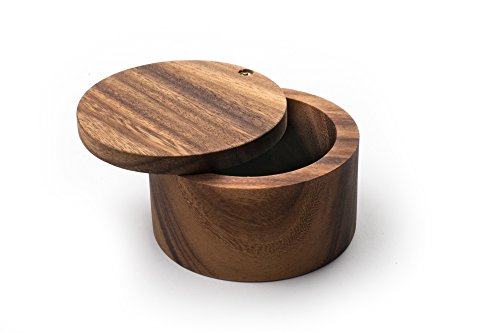
Htb Salt Cellar Lid
| Pros | Cons |
|---|---|
|
|
Our content is meticulously curated through independent research, testing, reviews, and AI-driven recommendations, all designed to present you with the finest product choices. When you make a purchase through our links, it could result in us earning a commission.

The best salt cellar lids of 2024 will ensure that your food receives the perfect level of saltiness thanks to how well these lids preserve the natural flavor of salt. On our list of the best salt cellar lids on the market, HTB Salt Cellar Lid is at the very top.
Do you have a salt cellar with a lid in your kitchen? A salt cellar with a lid is a small yet secure container that is either made out of ceramic, wood, or metal. As the name suggests, salt cellars are used to store salt. The most remarkable thing about salt cellars with lids is their tight-fitting covers, which prevent salt from becoming contaminated by dirt and debris.
Here's a brief manual that can help you track the most amazing salt cellars with lids without making much effort.
Salt cellars are used to store salt and other condiments. They come in a variety of shapes, sizes, and materials, so it can be hard to choose the one that is right for you.
Do you prefer a round or square design? Round salt cellars are typically more traditional and have a more elegant look. Square salt cellars are more modern and practical, as they take up less space on the dinner table.
The material from which the salt cellar is made cannot be taken for granted. Stainless steel and glass are both commonly used materials, but they each have their benefits.
Stainless steel is durable and easy to clean. Glass is fragile but can be easily decorated with etching or engraving. Some salt cellars are even made of bamboo.
If you are storing salt in your cellar, then the lid must create a seal to prevent moisture from getting in. Not all cellars have lids that seal tightly, so be sure to check before you buy.
There are many benefits of using salt cellars with lids. Some of them are as follows:
One advantage of using a lid is that it prevents the growth of fungus and bacteria, which can contaminate your salt and make it unusable for cooking.
A lid will keep your salt fresher over a longer period because the humidity in the air won't be able to reach it. Salt is hygroscopic, which means that it absorbs water from the air. This can cause the salt to become clumpy, making it difficult to use. By keeping the salt in an airtight container, it helps to prevent it from absorbing any moisture or other odors that may be present in the air. This can help preserve the flavor and freshness of the salt, making it a more desirable option for recipes.
Another benefit of using a salt cellar with a lid is that it helps to prevent accidental spills. This can be particularly helpful when storing salt in a location where there is a high risk of it being spilled, such as on a countertop or near the edge of a table. By keeping the salt in a sealed container, it helps to minimize the risk of it being spilled and making a mess. Keep the bad luck away by never having an accidental salt spill!
In addition to all the above-mentioned benefits, a salt cellar with a lid helps to keep any unused salt fresh for future use. You can store the salt for a longer period without having to worry about it going stale or losing its freshness.
Here are three simple methods for keeping your salt cellars clean and protected.
There are three main types of salt cellars: the classic wooden barrel, the ceramic pottery type with a metal lid, and the porcelain container with a stopper. The first two types have been around for centuries, while the last one has only recently shown up on shelves at stores.
The classic wooden barrel salt cellar is the most popular type. It's usually made of oak or other hardwood and has a brass band around the middle. The barrel rests on three small legs, which keep it stable on the countertop. The lid screws off so you can add or remove salt as needed.
This style of the salt cellar is the most common for a reason. It's made with quality materials that are durable enough to last multiple seasons, and it also looks good in your kitchen. Wood is used to make salt cellars because of its natural resistance against humidity and other environmental factors.
Ceramic salt cellars usually have a metal lid and are made of clay. They often come in different colors, which is why they're so popular with people who like to decorate their kitchens with theme-specific settings.
However, the lids on these containers don't always seal tightly enough to prevent powders from getting stale or clumping together. Ceramic salt cellars are a good choice if you're looking for something with a bit more personality than the classic barrel design. They also tend to be less expensive than porcelain or glass containers.
Porcelain salt cellars are made from clay, but they're fired at a much higher temperature than other types. This gives the material extra strength and durability to prevent chips or cracks from forming after repeated use. Porcelain has been used for many centuries in Asia because of its natural insulating properties. It's also very easy to clean, which is why it's the most popular type of salt cellar today.

| Pros | Cons |
|---|---|
|
|

| Pros | Cons |
|---|---|
|
|

| Pros | Cons |
|---|---|
|
|

| Pros | Cons |
|---|---|
|
|

| Pros | Cons |
|---|---|
|
|

| Pros | Cons |
|---|---|
|
|